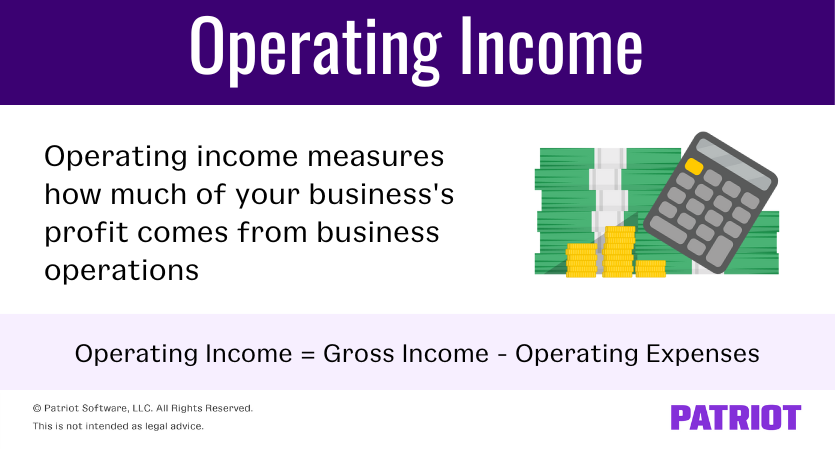When you are tracking your business’s financial health, you will track many indicators. And if you are seeking money from investors and creditors, they will want to see these numbers, too. Operating income is one of the numbers you should calculate.
What is operating income?
Operating income measures how much of your business’s profit comes from business operations. Operating income is your gross income minus operating expenses. You will not subtract interest and income taxes. And, you usually won’t subtract extraordinary gains and losses.
Synonyms for operating income include earnings before interest and taxes (EBIT), operating profit, recurring profit, and operating earnings.

Operating income vs. net income
Many people talk about operating income and net income interchangeably. However, they are not synonyms.
Net income is the bottom-line profit of a business after all expenses are subtracted, including interest and income tax.
Why is operating income important?
Operating income shows your business’s ability to generate earnings from its operational activities. Many business owners use the operating income figure to measure the operational successes of their business.
Investors and creditors might want to see your business’s operating income. They will use the figure to evaluate the business’s efficiency and profitability. They want to see that your business is healthy, growing, and able to pay off debts. A higher operating income means your business is more likely to pay back creditors.
How to calculate operating income
As mentioned before, operating income is your business’s gross income minus operating expenses, but before deducting interest, income tax, and extraordinary gains and losses.
The operating income formula looks like this:
Operating Income = Gross Income – Operating Expenses
Let’s look at the parts of the formula.
Gross income
Gross income is the amount of money your business has left after subtracting all costs associated with producing products.
To calculate operating income, you will first need to calculate gross income. So, what is gross income? To get your business’s gross income, subtract the cost of goods sold (COGS) from revenue. Do not include any extraordinary gains in your business revenue.
Gross Income = Revenue – COGS
If it’s easier for you, you can include this calculation in the operating income formula:
Operating Income = Revenue – COGS – Operating Expenses
Operating expenses
Operating expenses include all the costs associated with running your core business activities. These expenses might include rent, utilities, insurances, employee wages, freight and postage, and office supplies. Simply add all these together to calculate your operating expenses.
Do not include any extraordinary expenses in this calculation.
Operating income example
Philip’s Garden Center is a year-round garden supply store and nursery. Philip wants to take out a business loan and needs to show the business’s operating income to creditors.
He looks in his accounting software and learns that his business’s revenue was $350,000 during the previous year.
He had the following expenses:
Cost of goods sold: $25,000
Property and upkeep: $18,000
Utilities: $4,000
Employee wages: $140,000
Insurance: $10,000
Office supplies: $700
During the year, a bad storm blew a tree over on one of the business’s storage sheds. Insurance wouldn’t completely cover the damages, so Philip had to report a loss of $20,000.
Before Philip calculates operating income, he needs to calculate gross income. Remember, gross income is revenue minus COGS.
Revenue – COGS = Gross Income
$350,000 – $25,000 = $325,000
Next, he totals up operating expenses. In this case, the operating expenses include the property and upkeep, utilities, employee wages, insurance, and office supplies.
$18,000 + $4,000 + $140,000 + $10,000 + $700 = $172,700
Note that Philip didn’t include $20,000 worth of damages as an operating expense because it was an extraordinary loss.
Now, he can calculate the operating income. He subtracts the operating expenses from the gross income.
Gross Income – Operating Expenses = Operating Income
$325,000 – $172,700 = $152,300
Philip can show his prospective creditors that the business’s operating income was $152,300 during the past year.
You can calculate your business’s operating income by using your accounting records. If you use Patriot’s online accounting software, you have access to easy-to-read records and reports. Get your free trial to see for yourself how simple the software is to use.
This article is updated from its original publication date of May 1, 2018.
This is not intended as legal advice; for more information, please click here.


